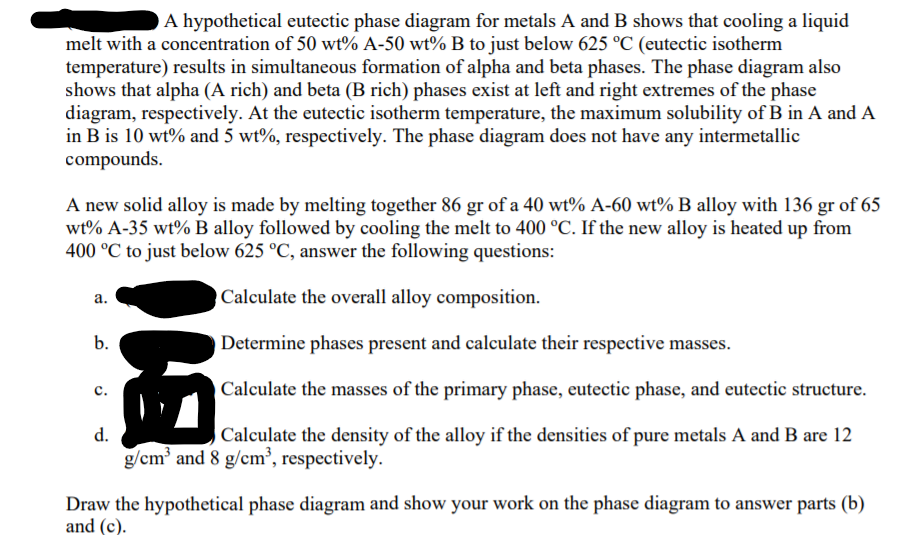A hypothetical eutectic phase diagram for metals A and B shows that cooling a liquid melt with a concentration of 50 wt% A-50 wt% B to just below 625 °C (eutectic isotherm temperature) results in simultaneous formation of alpha and beta phases. The phase diagram also shows that alpha (A rich) and beta (B rich) phases exist at left and right extremes of the phase diagram, respectively. At the eutectic isotherm temperature, the maximum solubility of B in A and A in B is 10 wt% and 5 wt%, respectively. The phase diagram does not have any intermetallic compounds. A new solid alloy is made by melting together 86 gr of a 40 wt% A-60 wt% B alloy with 136 gr of 65 wt% A-35 wt% B alloy followed by cooling the melt to 400 °C. If the new alloy is heated up from 400 °C to just below 625 °C, answer the following questions: Calculate the overall alloy composition. а. b. Determine phases present and calculate their respective masses. Calculate the masses of the primary phase, eutectic phase, and eutectic structure. с. d. |Calculate the density of the alloy if the densities of pure metals A and B are 12 g/cm' and 8 g/cm², respectively. Draw the hypothetical phase diagram and show your work on the phase diagram to answer parts (b) and (c).
A hypothetical eutectic phase diagram for metals A and B shows that cooling a liquid melt with a concentration of 50 wt% A-50 wt% B to just below 625 °C (eutectic isotherm temperature) results in simultaneous formation of alpha and beta phases. The phase diagram also shows that alpha (A rich) and beta (B rich) phases exist at left and right extremes of the phase diagram, respectively. At the eutectic isotherm temperature, the maximum solubility of B in A and A in B is 10 wt% and 5 wt%, respectively. The phase diagram does not have any intermetallic compounds. A new solid alloy is made by melting together 86 gr of a 40 wt% A-60 wt% B alloy with 136 gr of 65 wt% A-35 wt% B alloy followed by cooling the melt to 400 °C. If the new alloy is heated up from 400 °C to just below 625 °C, answer the following questions: Calculate the overall alloy composition. а. b. Determine phases present and calculate their respective masses. Calculate the masses of the primary phase, eutectic phase, and eutectic structure. с. d. |Calculate the density of the alloy if the densities of pure metals A and B are 12 g/cm' and 8 g/cm², respectively. Draw the hypothetical phase diagram and show your work on the phase diagram to answer parts (b) and (c).
Elements Of Electromagnetics
7th Edition
ISBN:9780190698614
Author:Sadiku, Matthew N. O.
Publisher:Sadiku, Matthew N. O.
ChapterMA: Math Assessment
Section: Chapter Questions
Problem 1.1MA
Related questions
Question

Transcribed Image Text:A hypothetical eutectic phase diagram for metals A and B shows that cooling a liquid
melt with a concentration of 50 wt% A-50 wt% B to just below 625 °C (eutectic isotherm
temperature) results in simultaneous formation of alpha and beta phases. The phase diagram also
shows that alpha (A rich) and beta (B rich) phases exist at left and right extremes of the phase
diagram, respectively. At the eutectic isotherm temperature, the maximum solubility of B in A and A
in B is 10 wt% and 5 wt%, respectively. The phase diagram does not have any intermetallic
compounds.
A new solid alloy is made by melting together 86 gr of a 40 wt% A-60 wt% B alloy with 136 gr of 65
wt% A-35 wt% B alloy followed by cooling the melt to 400 °C. If the new alloy is heated up from
400 °C to just below 625 °C, answer the following questions:
a.
Calculate the overall alloy composition.
b.
Determine phases present and calculate their respective masses.
Calculate the masses of the primary phase, eutectic phase, and eutectic structure.
с.
d.
Calculate the density of the alloy if the densities of pure metals A and B are 12
g/cm' and 8 g/cm³, respectively.
Draw the hypothetical phase diagram and show your work on the phase diagram to answer parts (b)
and (c).
Expert Solution
This question has been solved!
Explore an expertly crafted, step-by-step solution for a thorough understanding of key concepts.
Step by step
Solved in 5 steps with 5 images

Knowledge Booster
Learn more about
Need a deep-dive on the concept behind this application? Look no further. Learn more about this topic, mechanical-engineering and related others by exploring similar questions and additional content below.Recommended textbooks for you

Elements Of Electromagnetics
Mechanical Engineering
ISBN:
9780190698614
Author:
Sadiku, Matthew N. O.
Publisher:
Oxford University Press

Mechanics of Materials (10th Edition)
Mechanical Engineering
ISBN:
9780134319650
Author:
Russell C. Hibbeler
Publisher:
PEARSON

Thermodynamics: An Engineering Approach
Mechanical Engineering
ISBN:
9781259822674
Author:
Yunus A. Cengel Dr., Michael A. Boles
Publisher:
McGraw-Hill Education

Elements Of Electromagnetics
Mechanical Engineering
ISBN:
9780190698614
Author:
Sadiku, Matthew N. O.
Publisher:
Oxford University Press

Mechanics of Materials (10th Edition)
Mechanical Engineering
ISBN:
9780134319650
Author:
Russell C. Hibbeler
Publisher:
PEARSON

Thermodynamics: An Engineering Approach
Mechanical Engineering
ISBN:
9781259822674
Author:
Yunus A. Cengel Dr., Michael A. Boles
Publisher:
McGraw-Hill Education

Control Systems Engineering
Mechanical Engineering
ISBN:
9781118170519
Author:
Norman S. Nise
Publisher:
WILEY

Mechanics of Materials (MindTap Course List)
Mechanical Engineering
ISBN:
9781337093347
Author:
Barry J. Goodno, James M. Gere
Publisher:
Cengage Learning

Engineering Mechanics: Statics
Mechanical Engineering
ISBN:
9781118807330
Author:
James L. Meriam, L. G. Kraige, J. N. Bolton
Publisher:
WILEY